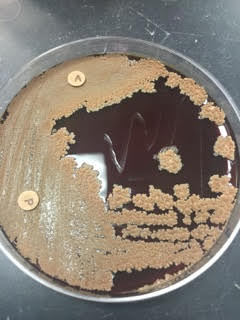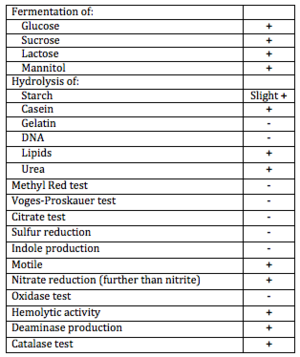Microorganism Bacillus licheniformis
Classification
Domain: Bacteria; Phylum: Firmicutes; Class: Bacilli; Order: Bacillales; family: Bacillaceae; Genus: Bacillus;
Species
|
NCBI: Taxonomy |
Bacillus licheniformis
Habitat Information
Bacillus licheniformis is a nonpathogenic soil organism. Because it is capable of forming endospores that can be easily disseminated, B. licheniformis can be isolated from a variety of places, though it is mainly associated with plant materials. It is also often found on feathers of ground-dwelling and aquatic species of birds.
Description and Significance
Describe the appearance (colonial and cellular), possible antimicrobial activity etc. of the organism, and why the organism might be significant.
B. licheniformis is a rod-shaped, gram positive motile bacterium. It is spore-forming under harsh conditions and closely related to the widely studied B. subtilis. Unlike other bacilli which are predominately aerobic, B. licheniformis is a facultative anaerobe, which explains it's ability to grow in additional ecological niches and environments.
Colonies are both round and irregular in shape, with irregular (undulate, fimbriate) margins. The surface of B. licheniformis colonies are often rough and wrinkled, with "licheniform", or hair-like growths. Color ranges from opaque to white.
B. licheniformis exhibits antimicrobial activity against both E. coli and S. aureus. It is also resistant to some commonly used antibiotics, including oxacillin and nafcillin.
Genome Structure
Describe the size and content of the genome. How many chromosomes? Circular or linear? Other interesting features? What is known about its sequence? Include S Ribosomal sequence that you obtained from PCR and sequencing here.
NEEDS TO BE REWRITTEN
We determined the complete nucleotide sequence of the B. licheniformis ATCC 14580 genome which comprises a circular chromosome of 4,222,336 base-pairs (bp) containing 4,208 predicted protein-coding genes with an average size of 873 bp, seven rRNA operons, and 72 tRNA genes. The B. licheniformis chromosome contains large regions that are colinear with the genomes of B. subtilis and Bacillus halodurans, and approximately 80% of the predicted B. licheniformis coding sequences have B. subtilis orthologs.
Cell Structure, Metabolism and Life Cycle
Interesting features of cell structure; how it gains energy; what important molecules it produces.
Optimal growth of Bacillus licheniformis occurs around 50°C, but the organism can survive at much higher/lower temperatures for extended because it is spore-forming. This spore-forming ability allows the organism to survive in a variety of harsh environments (high salt concentrations, for example) until conditions are more favorable, when it returns to a vegetative state. Optimal temperature for enzyme secretion is at human body temperature, 37°C. B. licheniformis produces many extracellular enzymes, including proteases and lipases which aid in digestion of proteins and fats, respectively. It is also a facultative anaerobe.
Physiology and Pathogenesis
Biochemical characteristics, enzymes made, other characteristics that may be used to identify the organism; contributions to environment (if any).
If relevant, how does this organism cause disease? Human, animal, plant hosts? Virulence factors, as well as patient symptoms.
closely related to Bacillus subtilis
B. licheniformis lives in the barbules, or terminal branches of the barbs of a bird feather. The organism secretes a keratinase which is capable of complete degradation of a feather within 24 hours, as feathers are made up of 90% keratin.
Some toxins produced by B. licheniformis have been shown to cause food poisoning in humans. Outbreaks are predominately associated with cooked meats, vegetables, milk products, and baby food. Because B. licheniformis is spore-forming, it it likely to survive industrial processing, i.e. milk pasteurization. Although B. licheniformis often occurs in high numbers in these foods, it's presence is not usually regulated in contrast to B. cereus, which is credited with most food poisoning incidents by the Bacillus species. Food poisoning can cause cramping, nausea, vomiting, and diarrhea, and fatalities by B. licheniformis toxins, though rare, have been reported.
NEEDS TO BE REWRITTEN
There are numerous commercial and agricultural uses for B. licheniformis and its extracellular products. The species has been used for decades in the manufacture of industrial enzymes including several proteases, α-amylase, penicillinase, pentosanase, cycloglucosyltransferase, β-mannanase and several pectinolytic enzymes. The proteases from B. licheniformis are used in the detergent industry as well as for dehairing and bating of leather [2,3]. Amylases from B. licheniformis are deployed for the hydrolysis of starch, desizing of textiles and sizing of paper [3]. Specific B. licheniformis strains are also used to produce peptide antibiotics such as bacitracin and proticin in addition to a number of specialty chemicals such as citric acid, inosine, inosinic acid and poly-γ-glutamic acid [4]. Some B. licheniformis isolates can mitigate the affects of fungal pathogens on maize, grasses and vegetable crops [5]. As an endospore-forming bacterium, the ability of the organism to survive under unfavorable environmental conditions may enhance its potential as a natural biocontrol agent.
Applications
Feathers are a major by-product of the poultry processing industry that are particularly difficult to degrade. Keratinolytic activities of B. licheniformis could aid in converting this by-product into a useful protein source for animal feed. The ability to turn waste feathers into feed would reduce feed costs and decrease the need for pollutants currently used to degrade these feathers.
Scientists at Newcastle University have been researching how the organism's ability to release an enzyme that breaks down external DNA may aid in breakdown of dental biofilms, or plaque. Lab tests have confirmed the enzyme's ability to break up and remove bacteria present in plaque, and thus prevent the build up of plaque. Addition of this enzyme to toothpastes, mouthwash, etc. could help reduce the prevalence of dental caries. [5]
References
(5) Wilkinson, T. (4 July 4 2012). "Seaweed could fight tooth decay – scientists". Independent.ie.
Author
Page authored by Clarissa Alejando and Erin Collins, students of Prof. Kristine Hollingsworth at Austin Community College.



